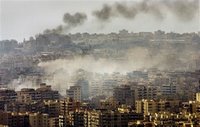 Every asymmetric war is fought through the media, and the Israel-Hezbollah conflict is no exception. You would think journalists themselves would know that, and be careful not be used. You would think too that reports of tragedy and carnage would be treated as carefully as absolutely possible.
Every asymmetric war is fought through the media, and the Israel-Hezbollah conflict is no exception. You would think journalists themselves would know that, and be careful not be used. You would think too that reports of tragedy and carnage would be treated as carefully as absolutely possible. It appears they're not so careful.
It appears they're not so careful.Jihad Watch has been playing spot the difference with the Reuters photos below. Which one do you think is real? Why has Reuters been tinkering with their photos, and what does it say for their claims of objectivity? Jihad Watch asks and answers the questions.
 And speaking of journalistic objectivity and being used, EU Referendum fisks the famous photo of the Qana tragedy. Make up your own mind who's using whom. And be careful what you read.
And speaking of journalistic objectivity and being used, EU Referendum fisks the famous photo of the Qana tragedy. Make up your own mind who's using whom. And be careful what you read.LINKS: Reuters admits doctoring photo, kills doctored version - Jihad Watch
Reuters doctoring photos to make Israel look bad? - Jihad Watch (Sun Aug 6)
Qana - the director's cut - EU Referendum
RELATED: Israel, Politics-World
5 comments:
The Red Cross is also investigating the issue, so that could be interesting as well.
One shudders to think of living in a world where the only news comes through National Radio, the NZ Herald, Reuters, AP and CNN. We have lived in such a world, and we have been manipulated much more than we have ever realised.
I wouldn't be surprised if the tip-off for the doctored photo came from Israel’s intelligence services or researchers from the military industries.
Since Israel is at the forefront of inventing cutting edge new technology, I have once read an article that the Mossad, Shin Beth, and military intelligence agencies have designed state-of-the-art machine intelligence software (artificial intelligence - AI) to analyse just about any data that is vital for national security.
A sub-branch of AI called 'Machine Vision' also known as 'Computer Vision’, which deals with intelligent image analysis or image recognition (object recognition) from a visual scene such as an image.
Technion Institute from Israel is a leader in designing computer vision systems for military use plus civilian use. Link [#3] shown below is a research paper done at Technion of how to detect scene containing multiple objects. The Reuters doctored photo has been alleged to have cloned a single object (a burning building) twice. Such cloning object can be easily detected using the algorithm, described in Lin [#3]. I would not be surprised if software has been developed out of this research paper, but clearly, the concept described in this paper, shows that such software can detect multiple clone of object from an image scenery even it is unnoticeable to the unsuspecting eyes. This is why, I wouldn't be surprised if this doctored photo has been a tipped off from Israel's scientific community or military intelligence.
The following links, relate to R&D being done at Technion Institute Israel.
[#1]"ISRAEL COMPUTER VISION HOMEPAGE"
http://visl.technion.ac.il/icv/
[#2]"Technion ISL Center for Intelligent Systems"
http://www.cs.technion.ac.il/Labs/Isl/
[#3]"Attention-based Dynamic Visual search using Inner Scene Similarity: Algorithms and Bounds"
http://www.cs.technion.ac.il/users/wwwb/cgi-bin/tr-info.cgi/2003/CIS/CIS-2003-02
Yep, falafulu, Israel's intelligence is so good that they're not surprised at all when Hezbollah fires an anti-ship missile at their ships and that's why they made sure they had the anti-missile defense system turned on.
http://www.youtube.com/watch?v=t_B1H-1opys
Pallywood.
Falfulu Fisi said...
[... Israel is a leader in designing computer vision systems for military use plus civilian use.]
Israeli military do use sophisticated computer vision software to detect missile-launching sites such as used by Hezbolla from Lebanon. As any technology, there is no such thing as 100% success rate and the IDF vision systems is no exception. The IDF spy drones scan a vast area of southern Lebanon to detect objects such as missile batteries. All known shapes, forms, colour, tones of different missile images and their carriers are fed into the vision system so it learns to recognize such pattern (learning stage). The drones are then set to fly autonomously in a vast area of enemy territory continually scanning the ground gathering images (real-time image acquisition), where the onboard vision systems, try to dissect every frame looking to see if any pattern from the ground image matches (high statistical confidence) any of the image patterns that it had learnt previously (from its learning stage) which has been stored in its memory already. If a pattern is matched with a high confidence, then the drone will automatically alert the base controller to zoom in on a particular coordinate of the suspect object thus, to confirm if it (vision system) it is registering a 'false positive' (non-target registering as a genuine target) or a 'true positive' (legitimate target). Error often happens whenever there is a 'false positive', that is when the vision system identified a non-target but it tagged it as a target. If the judgement of the people at the base controller are no better than the judgement of the vision system and decided to go along with the system’s decision, then disaster happens when the target turned out to be civilian. The vision systems is wrong on such occasion plus the inability of the military personnel at the base to visually identify if the target is genuine, often leads to deaths of innocent civilians.
As always, technology has good use (military or civilian whatever your definition is) and of course other use could irritate some people. Vision system algorithm is irritating, when developed into functionality of soft-bots or just bots (internet crawlers), for spamming purposes. This is the reason, why you have to type-in some warped letters in this blog site (and other blog sites), for authentication thus blocking out crawlers with vision system algorithm. The vision algorithms are already available from literatures to detect warped text images, but I think that it won’t take long for Spam-bot software developers to caught up with those and adopt them. Warped image text in web sites is known as Human Interaction Proofs (HIP) and you can read about it here:
“Computers beat Humans at Single Character Recognition in Reading based HIP”
http://www.ceas.cc/papers-2005/160.pdf
Good use of vision systems are adopted in automated medical imaging diagnosis, manufacturing & industrial applications where defect goods are automatically separated to trash bins from the production lines, air-port security where vision systems is trained to recognize thousands of images of different potential illegal object where customs officials are alerted when something is suspicious. I think that Auckland airport is about to buy such systems or had already installed one. An article in the NZ Herald in 2005, mentioned that customs is interested to get such systems. Another good use is stopping spamming pornography image files as email attachment. If it is porno the anti-spamming vision algorithm recognized such image and blocked. If it is a genuine family photo, then it allows. There are also vision bots that crawls the internet and indexed porno sites, where it then blocks those from being accessed by kids (if parents subscribed to such services). Here are some papers on vision systems for blocking pornography (see end of message). IBM has a product that filters out pornographic images and it was developed at Haifa IBM research centre, Israel. Researchers from Israel pioneered the research in this field in the mid 1970s, where most of them left to the US to work in the military complex. Now Israel retains its best today where they contribute to their defence industry plus commercial use.
WARNINGS: The first 3 links contain nude pictures that might offend some readers.
[#1]“System for Screening Objectionable Images
Using Daubechies' Wavelets and Color Histograms”
http://www-db.stanford.edu/~wangz/project/imscreen/WIPE/wang.pdf
[#2] “DETECTING PORNOGRAPHIC IMAGES”
http://www.projekcarpet.com/detectingpornographicimages.pdf
[#3] “Automatic detection of human nudes”
http://www.cs.berkeley.edu/~daf/ko5.pdf
[#4] “Building systems to block pornography”
http://ewic.bcs.org/conferences/1999/imageret/papers/paper8.pdf
[#5] “Adult Image Detection Using Statistical Model and Neural Network”
http://www-rech.enic.fr/coresa2004/articles/p144-zheng.pdf
[#6] “Classifying offensive sites based on image content”
http://www.idi.ntnu.no/~willa/papers/site_classifier.pdf
Post a Comment